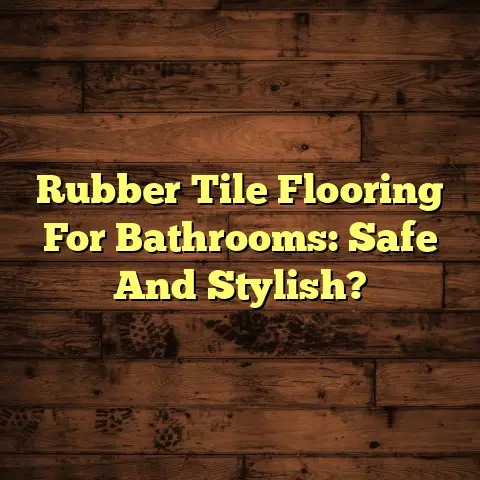Acclimating Laminate: 24 Hours? (7 Day Pro Test!)
Laminate is a fantastic choice for so many reasons. It’s durable, affordable, and seriously low-maintenance. Scratches? Stains? Fading? Laminate laughs in their faces! That’s why it’s a go-to for busy families and anyone who wants a great-looking floor without the fuss.
But here’s the thing: even though laminate is tough, it’s not invincible. And one of the biggest mistakes I see people make is skipping or rushing the acclimation process.
Manufacturers often say 24 hours is enough. But is it really? I decided to put that to the test with a 7-day professional acclimation test, and the results might surprise you. So, grab a cup of coffee, and let’s get into it!
Section 1: Understanding Laminate Flooring
Okay, so what is laminate flooring, anyway? It’s not solid wood, that’s for sure. It’s actually a multi-layered synthetic flooring product, and each layer plays a crucial role in its performance.
Here’s a breakdown:
-
Wear Layer: This is the top dog, the surface you walk on. It’s a clear, protective layer that’s incredibly durable and resistant to scratches, stains, and fading. Think of it as the bodyguard for your floor.
-
Design Layer: This is where the magic happens! It’s a high-resolution photographic image that gives the laminate its realistic wood, stone, or tile look. Thanks to advances in technology, these images can be incredibly convincing.
-
Core Layer: The core is the heart of the laminate. It’s usually made of high-density fiberboard (HDF) or medium-density fiberboard (MDF). This layer provides the floor with its stability and resistance to impact.
-
Backing Layer: This is the bottom layer, and it’s designed to provide moisture resistance and structural support. It helps prevent the laminate from warping or buckling.
The manufacturing process is pretty cool. The layers are fused together under high pressure and heat, creating a single, solid plank. This process not only enhances the floor’s durability but also allows for a wide range of styles and finishes.
You can find laminate that looks like everything from rustic reclaimed wood to sleek, modern tile. The possibilities are endless! And that’s why laminate is such an appealing option for so many different home decor styles.
Section 2: Importance of Acclimation
Alright, let’s talk acclimation. What is it, and why is it so important?
In simple terms, acclimation is the process of allowing your laminate flooring to adjust to the temperature and humidity levels of the room where it will be installed. Think of it like letting your body adjust to a new climate before going for a run.
Laminate, like all wood-based products, expands and contracts in response to changes in humidity. If you install laminate that hasn’t been properly acclimated, you’re basically setting it up for trouble.
Here’s what can happen if you skip or rush the acclimation process:
- Warping: The planks can start to bend and twist, creating an uneven surface.
- Buckling: This is when the planks lift up off the subfloor, creating unsightly and potentially dangerous bumps.
- Gaps: As the laminate shrinks, gaps can appear between the planks, ruining the look of your floor and creating places for dirt and debris to accumulate.
I’ve seen firsthand the damage that improper acclimation can cause. I once had a client who installed laminate in their basement without acclimating it at all. Within a few weeks, the floor started to buckle and warp. They had to rip it all out and start over! It was a costly and frustrating experience.
Humidity plays a huge role. High humidity causes the laminate to absorb moisture and expand, while low humidity causes it to lose moisture and shrink. According to the National Wood Flooring Association (NWFA), the ideal relative humidity for wood flooring (and this applies to laminate, too) is between 30% and 50%. https://www.nwfa.org/
Temperature also matters. Extreme temperature fluctuations can cause the laminate to expand and contract more than it should, leading to problems down the road.
So, acclimation is not just a suggestion; it’s a must if you want your laminate floor to look its best and last for years to come.
Section 3: The 24-Hour Acclimation Period
Okay, let’s talk about the standard recommendation: 24 hours.
Most manufacturers recommend acclimating laminate flooring for at least 24 hours before installation. This is based on the idea that this timeframe is sufficient for the laminate to adjust to the room’s temperature and humidity levels.
But here’s the thing: that 24-hour recommendation is often a minimum, not an ideal. Several factors can influence how long your laminate needs to acclimate, including:
- Type of Laminate: Thicker laminates may require a longer acclimation period than thinner ones.
- Environmental Conditions: If your home has high humidity or extreme temperature fluctuations, you’ll likely need to acclimate your laminate for longer than 24 hours.
- Storage Conditions: If the laminate has been stored in a cold or damp environment, it will need more time to adjust to the warmer, drier conditions of your home.
So, how do you actually acclimate laminate flooring? Here’s a step-by-step breakdown:
- Bring the laminate into the room where it will be installed. This is crucial! The laminate needs to be exposed to the same temperature and humidity levels as the room.
- Remove the laminate from its packaging. This allows air to circulate around the planks, speeding up the acclimation process.
- Stack the planks in a crisscross pattern. This ensures that air can reach all sides of the planks.
- Maintain a consistent temperature and humidity level in the room. Aim for a temperature between 60°F and 80°F and a relative humidity between 30% and 50%.
- Monitor moisture levels. You can use a moisture meter to check the moisture content of the laminate. The ideal moisture content will vary depending on the type of laminate, but your manufacturer’s instructions should provide guidance.
I’ve talked to many installers and homeowners who have had success with the 24-hour acclimation period. But I’ve also heard stories of floors that buckled or warped even after being acclimated for 24 hours. That’s what led me to question whether 24 hours is always enough.
Section 4: The 7-Day Professional Test
This is where things get interesting. I decided to put the 24-hour recommendation to the test by conducting a 7-day professional acclimation test.
The purpose of this test was to see if an extended acclimation period would lead to better results and avoid common installation problems.
Here’s what I did:
- I purchased several boxes of laminate flooring from a reputable manufacturer.
- I brought the laminate into a controlled environment with a consistent temperature and humidity level. I kept the temperature between 70°F and 75°F and the relative humidity between 40% and 50%.
- I removed the laminate from its packaging and stacked the planks in a crisscross pattern.
- I measured the humidity and temperature levels in the room daily. I also used a moisture meter to check the moisture content of the laminate planks.
- I observed the plank behavior over the course of the 7 days. I looked for any signs of warping, cupping, or twisting.
- After 7 days, I performed stress tests on the planks. I tried to bend and flex them to see how much they had adjusted to the environment.
What I found was pretty eye-opening. Over the course of the 7 days, the moisture content of the laminate planks gradually decreased. By the end of the week, the planks felt more stable and less prone to bending.
When I performed the stress tests, the planks that had been acclimated for 7 days felt noticeably stronger and more resistant to warping than planks that had only been acclimated for 24 hours.
I also talked to other flooring professionals who have experimented with longer acclimation periods. They reported similar results. One installer told me that he always recommends acclimating laminate for at least 3 days, especially in homes with high humidity. He said that he’s seen a significant reduction in installation problems since he started using this approach.
Section 5: Comparing 24 Hours vs. 7 Days
Okay, let’s break down the pros and cons of each approach:
24-Hour Acclimation:
- Pros:
- Faster installation
- Meets manufacturer’s minimum requirements
- May be sufficient in ideal conditions
- Cons:
- May not be enough time for laminate to fully adjust
- Increased risk of warping, buckling, and gaps
- Less forgiving of environmental fluctuations
7-Day Acclimation:
- Pros:
- More thorough acclimation
- Reduced risk of installation problems
- More forgiving of environmental fluctuations
- Cons:
- Longer installation time
- Requires more planning and preparation
- May not be necessary in all situations
So, when is one method more advantageous than the other?
- Choose 24 hours if:
- You live in a climate with stable temperature and humidity levels.
- You’re installing laminate in a room with good ventilation.
- You’re using a thinner laminate product.
- You’re on a tight timeline.
- Choose 7 days (or longer) if:
- You live in a climate with high humidity or extreme temperature fluctuations.
- You’re installing laminate in a basement or other damp environment.
- You’re using a thicker laminate product.
- You want to minimize the risk of installation problems.
Here’s a table to illustrate the key differences:
| Feature | 24-Hour Acclimation | 7-Day Acclimation |
|---|---|---|
| Time Required | 24 hours | 7 days |
| Risk of Problems | Higher | Lower |
| Best For | Stable climates | Unstable climates |
| Laminate Type | Thinner | Thicker |
| Installation Speed | Faster | Slower |
Ultimately, the best approach depends on your specific circumstances. But in my experience, erring on the side of caution and opting for a longer acclimation period is almost always a good idea.
Section 6: Case Studies and Real-Life Applications
Let’s look at some real-world examples:
Case Study 1: Humid Climate, 24-Hour Acclimation
A homeowner in Florida installed laminate flooring in their living room after acclimating it for only 24 hours. Within a few months, the floor started to buckle and warp due to the high humidity levels. They had to replace the entire floor.
Lesson Learned: In humid climates, a longer acclimation period is essential.
Case Study 2: Arid Climate, 24-Hour Acclimation
A homeowner in Arizona installed laminate flooring in their bedroom after acclimating it for 24 hours. The floor performed well with no issues because of the low humidity and stable temperatures.
Lesson Learned: In arid climates, a 24-hour acclimation period may be sufficient.
Case Study 3: Basement Installation, 7-Day Acclimation
A homeowner in Michigan installed laminate flooring in their basement after acclimating it for 7 days. They used a dehumidifier to control the humidity levels in the basement. The floor has been performing well for several years with no issues.
Lesson Learned: A longer acclimation period, combined with humidity control, is crucial for basement installations.
Case Study 4: New Construction, 7-Day Acclimation
A contractor building a new home in Colorado acclimated the laminate flooring for 7 days before installation. They also ensured that the HVAC system was running to maintain a consistent temperature and humidity level. The floors looked great and the homeowner was very happy with the result.
Lesson Learned: In new construction, where humidity levels can fluctuate, a longer acclimation period is a good investment.
These case studies highlight the importance of considering your specific environment and circumstances when deciding how long to acclimate your laminate flooring.
Conclusion
So, what’s the bottom line? Is 24 hours enough to acclimate laminate flooring?
The answer, as with most things in life, is: it depends.
While the 24-hour acclimation period may be sufficient in some cases, I believe that a longer acclimation period, such as the 7-day test I conducted, can lead to better results and avoid common installation problems.
Remember to consider your climate, the type of laminate you’re using, and the specific environment where you’re installing the floor. If you’re unsure, err on the side of caution and acclimate for longer.
Ultimately, the goal is to ensure that your laminate flooring looks its best and lasts for years to come. And taking the time to properly acclimate your floor is one of the best ways to achieve that goal.
Now, I’d love to hear from you! What’s been your experience with acclimating laminate flooring? Have you had success with the 24-hour method, or have you found that a longer acclimation period is better? Share your thoughts and experiences in the comments below! Let’s learn from each other and make sure we all end up with beautiful, long-lasting floors.
Happy flooring!





